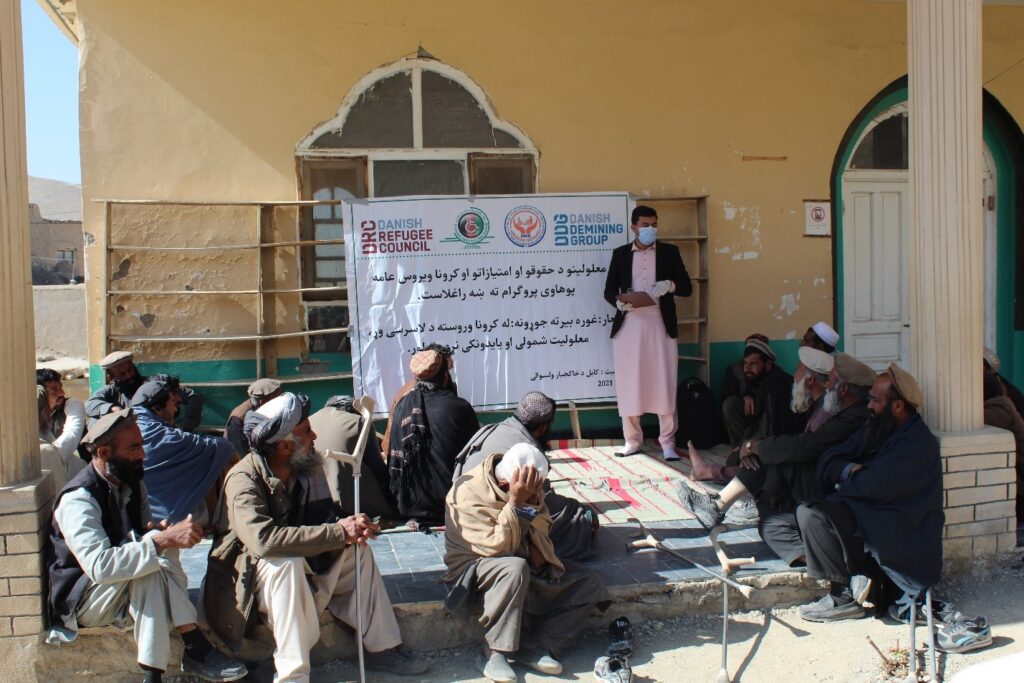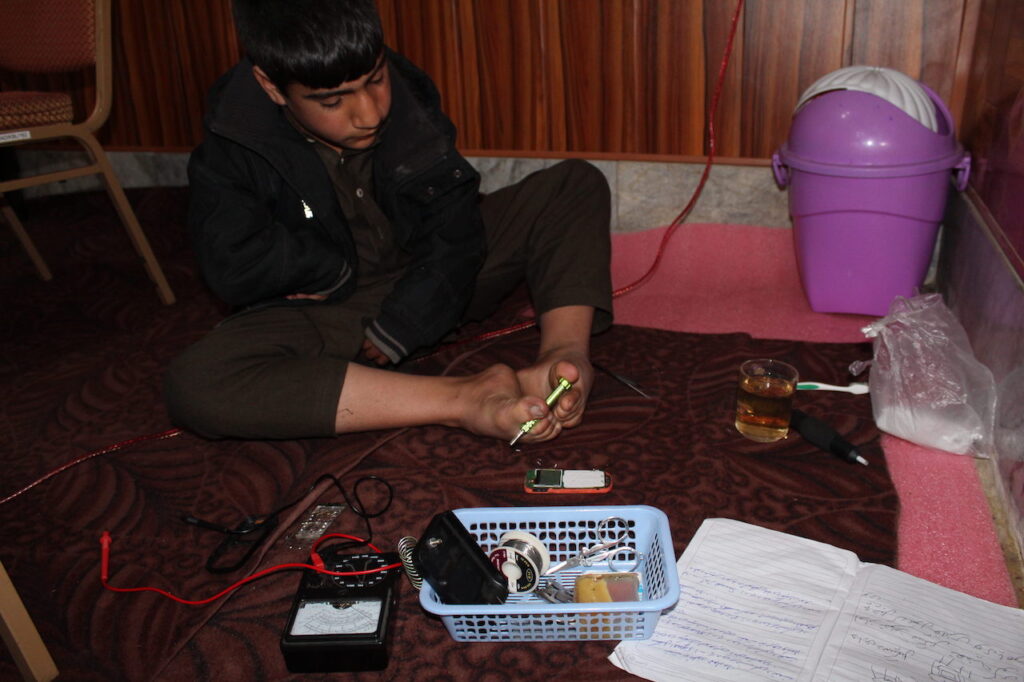AOAD History

History and Legal Status
History and Legal Status: AOAD was first founded through a small grant project of ABILIS Foundation of Finland for physical accessibility, building-Ramps constructions in the schools in Kabul in 2007. Before this AOAD was working as an informal common social platform for Persons with Disabilities (PWD), who were working as volunteers for their rights and recognition and full participation.
Established in May 2007 and based in Kabul-Afghanistan, Accessibility Organization for Afghan Disabled (AOAD) is a non-governmental, non-profit and non-political organization, formed by Persons with Disabilities (PWD) and working for Persons with Disabilities, their direct family members, women rights, and other vulnerable and segregated groups, as peer-support and disability advocacy organization. Under Registration number No.956, AOAD is registered with the Ministry of Economy of the Islamic Republic of Afghanistan. AOAD promotes disability rights and inclusion in line with the Convention on the Rights of Persons with Disabilities (CRPD), and Sustainable Development Goals (SDGs 2015-2030). We are now serving as an umbrella organization for the traditional rural Disabled Person Organizations (DOPs) which were instrumental in the creation of AOAD as a formal disability organization.



Scope and Organizational Capabilities
As a grassroots organization, AOAD is actively bridging between the most deprived, neglected, and forgotten rural communities and the donors, governments, policy, and decision-makers at the top level of power. Currently, AOAD, with 300 field workers, 220 local volunteers, 22 Disabled Peoples’ Organizations (DPOs) and community self-help groups, 50 AOAD Program-Focal-Points (PFPs), and 5 sister NGOs, have access to the entire 34 provinces of Afghanistan. Out of eight operational regions of Afghanistan AOAD has a direct operational presence in five regions, in the remaining three regions AOAD accesses vulnerable communities through DOPs, program focal points, and sister NGOs. With this network of community interconnectivity, we bring the voice of those who have no public voice.
With over a 2 million USD annual budget AOAD serves 32200 direct and over 50,000 indirect beneficiaries, mostly PwDs, women, men, and children of the most vulnerable communities in the hard-to-reach geographical localities. With a programmatic focus on the priority needs of PwDs, IDPs, and vulnerable women and children, AOAD is a specialized NGO in physical rehabilitation, psychosocial counseling, inclusive education, employment support, skill-training, income generation, victims’ assistance, MRE, advocacy and emergency food supply.
On November 5, 2018, AOAD received membership from the Afghanistan Humanitarian Fund (AHF) enabling AOAD to receive direct funding from the Humanitarian Aid & Assistance to refugees, returnees, and Internally Displaced People (IDPs). AOAD Facilitated fieldwork and data collection for various vulnerability surveys in the past and recently national-level research on physical accessibility which led to the development of a National Rehabilitation Guideline for the government of Afghanistan.
We are right based organization, working for capacity building of civil society organizations (CSOs), community self-help, rights advocacy, and awareness at the community grassroots level. Our humanitarian doctrine originates from the grassroots of the community with a community slogan of “Nothing for US without US”. We strongly believe and invest in direct and full community participation at all levels of our interventions


Partnership and Networking
We are a core member of the Afghan Campaign to Bann Landmine (ACBL). AOAD is an active stakeholder in the United Nations Humanitarians Country Team (HCT/UNOCHA), and a member of the UN health, FSAC, and Mine Action clusters. AOAD is a former Steering Committee member of ACBAR and a member of the Afghan C.S.O.’s Network. As a disability partner, before 15 August 2021, AOAD was closely working with the government and its line ministries, like the State Ministry of Martyrs and Disabled, the Ministry of Education, the Ministry of Refugees and Returnees (MORR), Afghanistan National Disaster Management Authority (ANDMA), and Ministry of Public Health (MoPH). AOAD received official Accreditation from the Directorate of Mine Action Coordination (DMAC) to implement projects for Victim Assistance, Persons with Disabilities, and conduct Mine Risk Education (MRE) projects. AOAD is an active program partner of the World Food Program WFP, European Union (EU) for a Consortium project with Swadesh Committee for Afghanistan and Save the Children International (EU, SCA/SCI). We are also long-term partner of the U.S. Department of State Weapon Removal Abatement (PM/WRA), Counterpart International (ACEP/CPI/USAID), WHO, Danish refugee Council DRC, AAR-Japan, UN-HABITAT, UNMAS, the UN country Humanitarian Funds (CHF). and IRC. As a major disability actor in Afghanistan, and internationally AOAD is extensively involved in world disability rights campaigns and advocacy. AOAD officially represents the Global Alliance on Accessible Technologies & Environment (GAATES) Canada, in Afghanistan. As a disability rights expert organization, AOAD has received several international disability awards and has cross-fertilized Afghan disability experience across 19 countries in the field of disability inclusion and disability rights and advocacy.
- As per the available national statistics, 13.9% Afghan Population have Severe disabilities which are more prevalent among females (14.9%) compared to males (12.6%). Among children aged 2–17 years, 17.3% have a mild, moderate, or severe disability. The incidence of severe disability among adults and children, which stood at 2.7% in 2005, has risen steeply to 13.9%, putting Afghanistan in unprecedented healthcare territory. Persons with Disabilities are among the 90% population which lives under the poverty line as the poorest of the poor in Afghanistan. Disability specialists have noted that this figure is estimated to be lowered due to the high mortality rate in Afghanistan from poor care for people with disability. They hypothesize that if access to quality care was improved, the rate of disability would be higher as more disabled persons would have survived and lived.
- 80% of the Afghan population lives more than 100km from a physical rehabilitation center and 20 out of 34 provinces do not have Prostheses and Orthoses facilities.
- Lack of access to adequate, expert care can leave persons with disabilities confined to their homes for weeks, months, or years, with ordinary conditions which could easily be addressed or alleviated by appropriate interventions.
However, with all these consequences Persons with Disabilities are living in a very vulnerable condition as the poorest of the poor in the country, experiencing widespread violations of their rights and dignity as a neglected portion of the population because of the decades stretched war and violence in Afghanistan.
AOAD Achievements
- AOAD from 2007 to 2020 in a glance:
AOAD has implemented 80 projects in the above-mentioned provinces and cities.
Constructed more than 600 Ramps and Slopes in 270 public buildings schools, health clinics, Mosques, and governmental departments. - Provided skills development Vocational training to more than 1100 Persons with Disabilities
- Including vulnerable family members of Persons with Disabilities.
- Secured jobs through lobbying for 200 Persons with Disabilities now they are working with NGOs, INGOs, and the government.
- 200 children with disabilities are rehabilitated and integrated into the education system by enrolling them in the public school system.
- 5- AOAD has provided Prostheses, Orthoses, and Physiotherapy to 10000 Afghans in Zabul and in Bamiyan provinces.
- Provided Civic Advocacy for the Rights of Persons with Disabilities according to the UNCRPD in 17 provinces.



Development Goals:
Goal 1: To have a society in which men and women with disabilities enjoy equal rights with all others to health, education, employment, and participation in public life and in which they are protected from all forms of discrimination.
Goal 2: To Improve physical access for all with Design for all.
Goal 3: To eliminate extreme poverty through skills development, vocational training for long-term self/help, and sustainable jobs for people with disability or their immediate family members.
Our Vision is: AOAD’s vision for disability inclusion is to ensure people with disabilities are consistently and systematically included in the development, education, political, and humanitarian assistance agenda with the slogan “Nothing about us without us”.
Our Mission: Resilience and full participation of parents and government for prevention of disabilities especially with the focus on Gender for mainstreaming disabilities so that persons with disabilities may fully participate in society and be able to influence their own development for a dignified and sustainable life.
AOAD Core-value:
- Accountability and Transparency
- Commitment
- Inclusion
- Partnership
Objectives of AOAD:
- Equality in socio-economic development
- Mainstreaming Persons with Disabilities in political agenda
- Equality and Empowerment
- Inclusion
- Physical access and design for all
- Providing Physical Rehabilitations
Director and Management: Executive Director: Abdul Khaliq Zazai (AOAD Founder), Country Representative of GAATES Canada for Afghanistan
